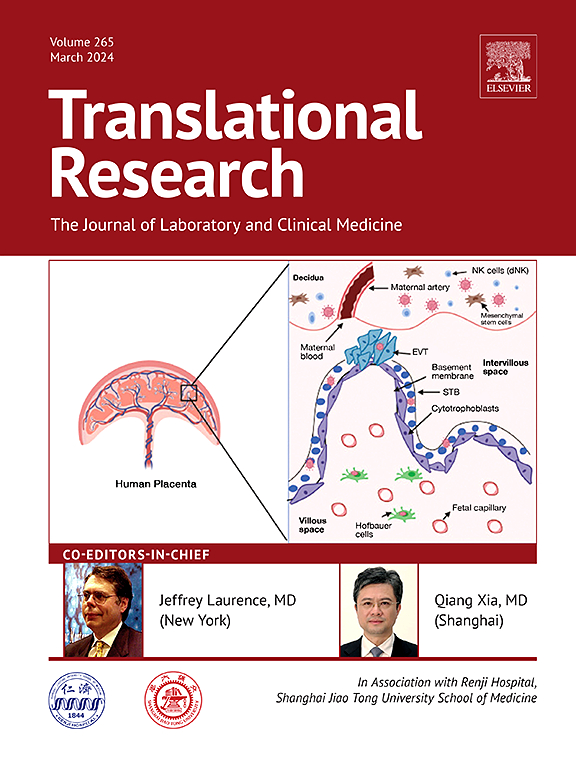通过单细胞 RNA 测序剖析左右侧结直肠癌的细胞重编程和肿瘤微环境
IF 6.4
2区 医学
Q1 MEDICAL LABORATORY TECHNOLOGY
引用次数: 0
摘要
分侧和分期是结直肠癌(CRC)肿瘤微环境(TME)差异的主要来源。基质细胞和免疫细胞的亚群组成以及细胞间的相互作用共同构成了 CRC 的免疫抑制微环境。在这项研究中,我们从公共数据库中全面收集了单细胞 RNA 测序数据。我们从 55 个 CRC 样本中筛选出 126,279 个细胞,以描述细胞组成的差异,并从时间和位置上阐明细胞类型的转录特征和潜在功能。与左侧癌细胞相比,我们观察到右侧特异性癌细胞的缺氧程度有所增加。癌症相关成纤维细胞(CAFs)的分子特征表明,它们与协调细胞外基质重塑和血管生成的功能密切相关,而右侧的CAFs具有更强的癌症侵袭信号特征。侧特异性癌细胞与基质细胞和免疫细胞之间的串扰是不同样本组 CRC 的特征,并与较差的预后有关。我们的研究捕捉到的免疫抑制模式在右侧 CRC 中表现出更复杂的细胞间相互作用。此外,在 CRC 恶性发展过程中,CD8+ T 细胞的细胞毒性和耗竭特性以及巨噬细胞的促炎和抗炎特性的转变,都是细胞重编程现象的缩影,即 TME 的功能从促进免疫转变为抑制免疫。我们的研究为完善左右侧 CRC 恶性进展过程中的个性化治疗方案提供了启示。本文章由计算机程序翻译,如有差异,请以英文原文为准。
Dissecting the cellular reprogramming and tumor microenvironment in left- and right-sided Colorectal Cancer by single cell RNA sequencing
Sidedness and staging are major sources of tumor microenvironment (TME) differences in colorectal cancer (CRC). Subpopulation compositions of stromal cells and immune cells, and interactions between cells collectively constitute the immunosuppressive microenvironment of CRC. In this study, we comprehensively collected single-cell RNA sequencing data from public databases. We filtered out 126,279 cells from 55 CRC samples to characterize the differences in cellular composition, and to elucidate the transcriptional features and potential functions of cell types, temporally and positionally. We observed an increased degree of hypoxia in right side-specific cancer cells compared to left-sided cancer. Cancer-associated fibroblasts (CAFs) illustrated molecular signatures tremendously tended to be associated with functions that orchestrate extracellular matrix remodeling and angiogenesis, and right-sided CAFs characterized the stronger cancer invasion signals. Crosstalk between side-specific cancer cells and stromal together with immune cells characterized CRC via different sample groups, and was pertinent to worse prognosis. Our study captured immunosuppressive pattern exhibiting more intricate intercellular interactions in right-sided CRC. Additionally, during malignant progression of CRC, the transformation of CD8+ T cell cytotoxic and exhausted properties and macrophage pro-inflammatory and anti-inflammatory properties epitomized the cellular reprogramming phenomenon that the function of TME shifted from promoting immunity to suppressive immunity. Our study shed lights on refining personalized therapeutic regimens during malignant progression in left- and right-sided CRCs.
求助全文
通过发布文献求助,成功后即可免费获取论文全文。
去求助
来源期刊

Translational Research
医学-医学:内科
CiteScore
15.70
自引率
0.00%
发文量
195
审稿时长
14 days
期刊介绍:
Translational Research (formerly The Journal of Laboratory and Clinical Medicine) delivers original investigations in the broad fields of laboratory, clinical, and public health research. Published monthly since 1915, it keeps readers up-to-date on significant biomedical research from all subspecialties of medicine.
 求助内容:
求助内容: 应助结果提醒方式:
应助结果提醒方式:


